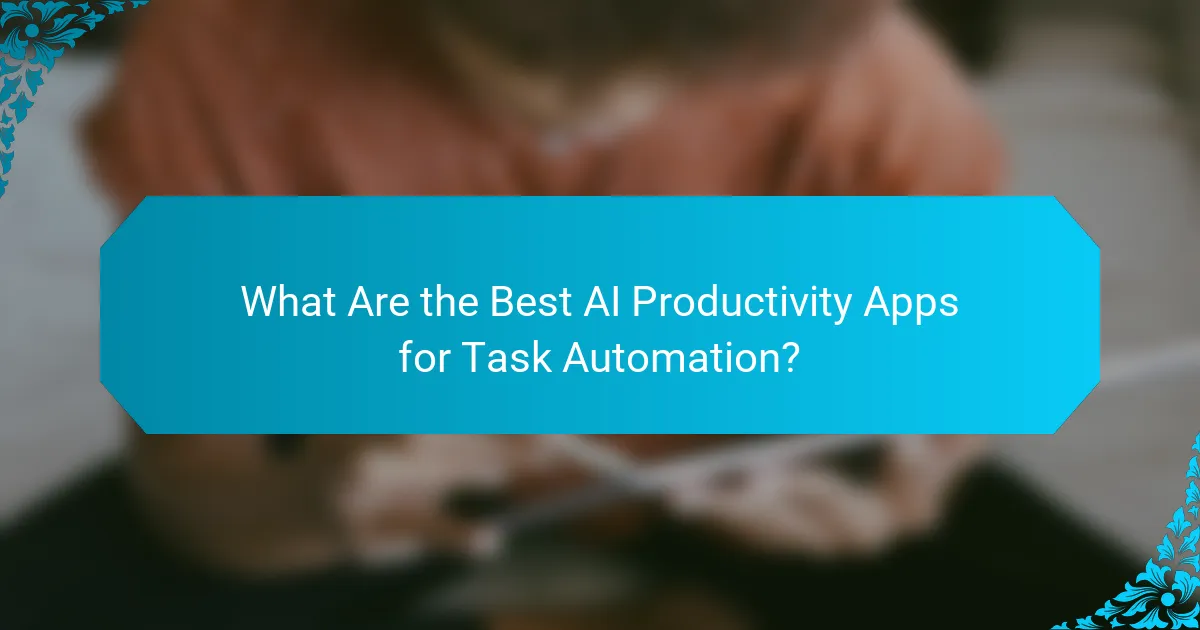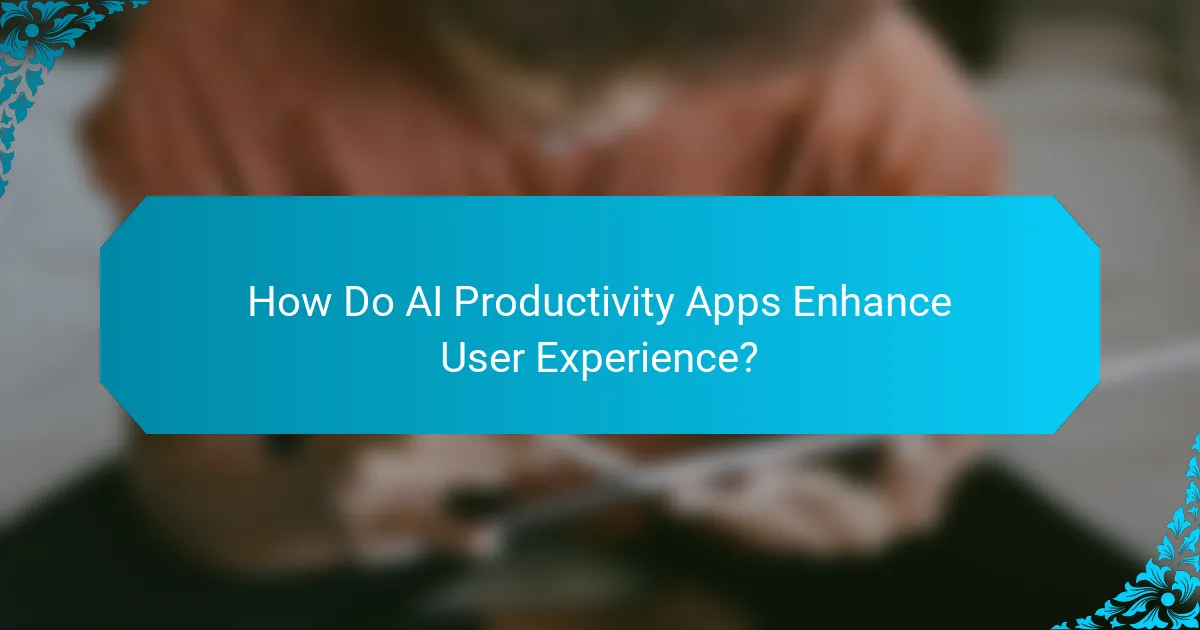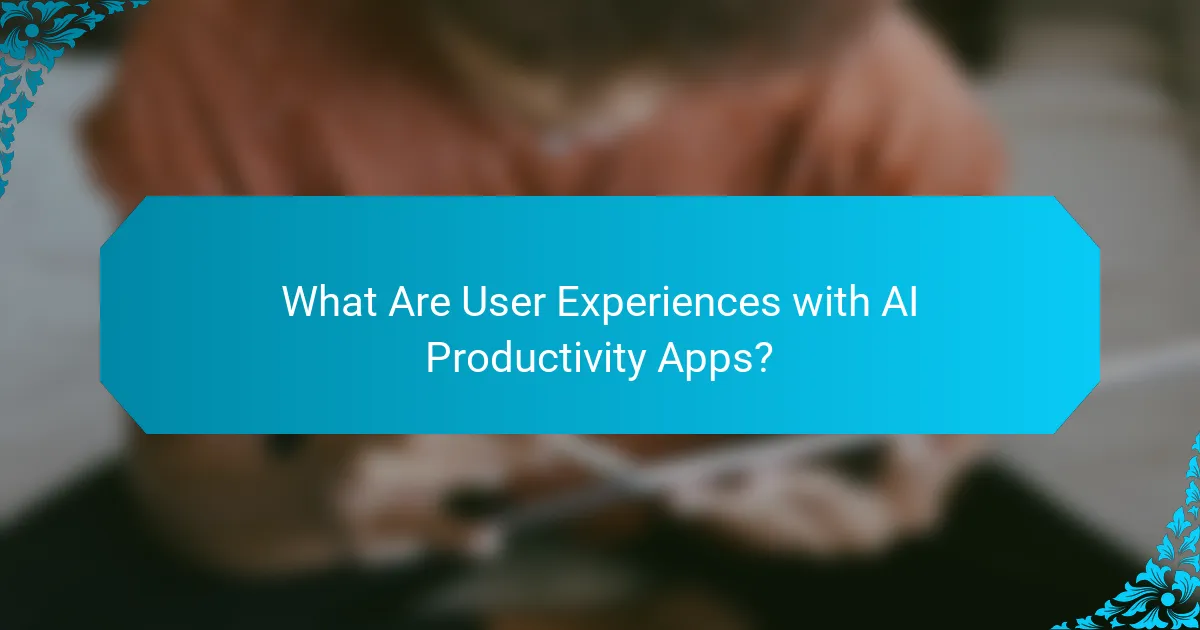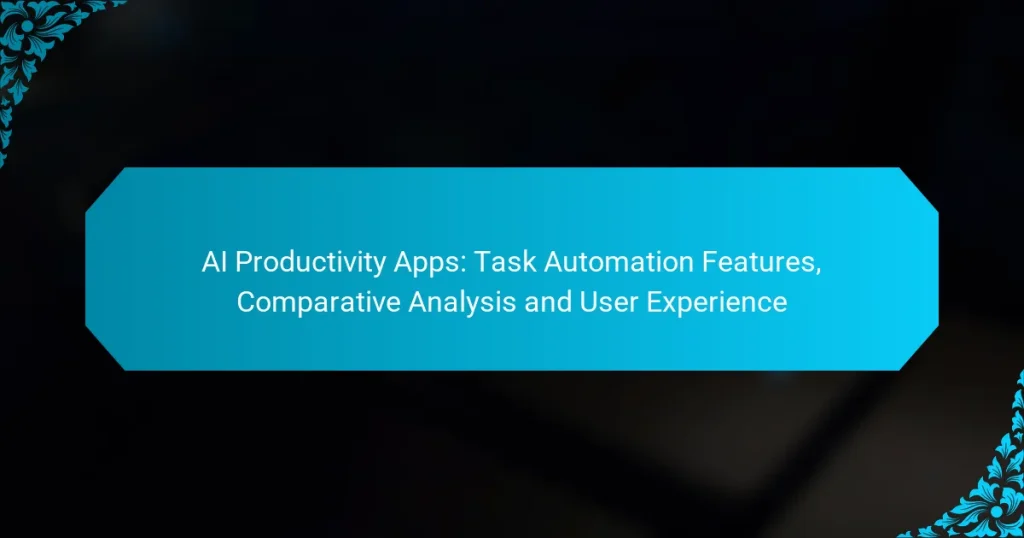AI productivity apps are revolutionizing the way we manage tasks by automating repetitive processes and integrating various applications. By focusing on task automation features, users can significantly enhance their efficiency and streamline workflows, allowing for more strategic engagement. This analysis delves into the comparative features of these applications, emphasizing user experience and the impact of automation on productivity.

What Are the Best AI Productivity Apps for Task Automation?
The best AI productivity apps for task automation streamline workflows by connecting various applications and automating repetitive tasks. These tools enhance efficiency and save time, allowing users to focus on more strategic activities.
Zapier
Zapier is a widely used automation tool that connects over 3,000 apps, enabling users to create automated workflows called “Zaps.” Each Zap consists of a trigger and one or more actions, allowing for seamless data transfer between applications.
Consider using Zapier for tasks like automatically saving email attachments to cloud storage or posting social media updates from a blog. Its user-friendly interface makes it accessible for both beginners and advanced users.
Integromat
Integromat, now known as Make, offers a visual interface for building complex automations between various apps. It supports multi-step workflows and allows users to manipulate data through filters and functions.
This tool is ideal for users needing advanced automation, such as aggregating data from multiple sources into one report. Integromat’s flexibility can cater to specific business needs, but it may require a steeper learning curve compared to simpler alternatives.
Microsoft Power Automate
Microsoft Power Automate integrates seamlessly with Microsoft 365 applications, making it an excellent choice for organizations already using this ecosystem. It allows users to automate workflows across Microsoft apps and third-party services.
Power Automate is particularly useful for automating approvals, notifications, and data collection. Users should be aware of licensing costs, which vary based on the features and number of flows needed.
Automate.io
Automate.io is a user-friendly automation platform that connects various cloud applications, allowing users to create simple one-to-one integrations or complex workflows. It supports over 200 apps and offers a straightforward drag-and-drop interface.
This tool is suitable for small to medium-sized businesses looking to automate marketing, sales, and customer support tasks. Users should note that the free plan has limitations on the number of tasks and apps that can be connected.
IFTTT
IFTTT (If This Then That) is a popular automation tool that focuses on simple conditional statements to trigger actions across various services. It is particularly user-friendly, making it ideal for personal use and small-scale automations.
Common use cases include automating smart home devices or syncing social media accounts. While IFTTT is easy to use, it may not offer the depth of features found in more complex platforms, making it less suitable for enterprise-level needs.

How Do AI Productivity Apps Enhance User Experience?
AI productivity apps enhance user experience by streamlining tasks, reducing manual effort, and improving overall efficiency. These applications leverage advanced algorithms to automate repetitive processes, allowing users to focus on more strategic activities.
Intuitive Interfaces
Intuitive interfaces in AI productivity apps simplify navigation and task management, making them accessible to users with varying technical skills. A well-designed interface often features drag-and-drop functionality, clear icons, and straightforward menus that minimize the learning curve.
For example, apps like Trello and Asana utilize card-based layouts that allow users to easily organize tasks visually. This design approach helps users quickly adapt and enhances their overall productivity.
Customizable Workflows
Customizable workflows enable users to tailor their task management processes to fit specific needs and preferences. Many AI productivity apps offer templates or automation rules that can be adjusted to reflect individual or team workflows.
For instance, users can set up automated reminders, recurring tasks, or conditional actions based on project progress. This flexibility allows teams to maintain consistency while adapting to changing project requirements.
Real-time Collaboration
Real-time collaboration features facilitate seamless communication and teamwork, allowing multiple users to work on tasks simultaneously. AI productivity apps often include chat functions, shared documents, and live updates to keep all team members informed.
Tools like Slack and Microsoft Teams exemplify this capability, enabling users to share files and feedback instantly. This fosters a more dynamic work environment, reducing delays and improving project outcomes.

What Task Automation Features Should You Look For?
When evaluating task automation features in AI productivity apps, focus on integration capabilities, trigger and action options, and analytics and reporting. These elements determine how well the app can streamline your workflow and provide insights into performance.
Integration Capabilities
Integration capabilities refer to how well the automation app connects with other software tools you use. Look for apps that support a wide range of integrations, including popular platforms like Google Workspace, Microsoft Office, and project management tools like Trello or Asana. The more integrations available, the easier it is to automate tasks across different applications.
Consider whether the app offers native integrations or requires third-party services like Zapier. Native integrations typically provide smoother functionality and faster setup. Always check the app’s integration library to ensure it meets your specific needs.
Trigger and Action Options
Trigger and action options define how tasks are initiated and what actions are performed in response. A robust automation tool should offer a variety of triggers, such as time-based schedules, incoming emails, or specific events in other applications. This flexibility allows you to automate diverse workflows effectively.
Evaluate the range of actions available after a trigger occurs. Common actions include sending notifications, updating records, or creating new tasks. The more options you have, the more complex and tailored your automation can be. Aim for apps that allow conditional logic, enabling actions based on specific criteria.
Analytics and Reporting
Analytics and reporting features provide insights into the effectiveness of your automated tasks. Look for apps that offer dashboards displaying key metrics, such as task completion rates and time saved. These insights can help you identify bottlenecks and optimize your processes.
Consider whether the app allows for customizable reports. This feature can be particularly useful for tracking performance over time or analyzing specific workflows. Regularly reviewing analytics can help you make informed decisions about adjusting your automation strategies for better efficiency.

How Do AI Productivity Apps Compare in Pricing?
AI productivity apps vary significantly in pricing, with options ranging from free basic plans to premium subscriptions costing several hundred dollars annually. Users should consider their specific needs and the features offered at each pricing tier to determine the best value.
Free vs Paid Plans
Free plans typically include essential features that allow users to automate basic tasks, but they may lack advanced functionalities. Paid plans often provide enhanced capabilities such as integrations with other tools, priority support, and additional customization options.
For example, a free plan might offer limited automation tasks per month, while a paid plan could allow unlimited tasks and access to premium templates. Users should evaluate whether the free version meets their needs or if the investment in a paid plan is justified.
Cost of Premium Features
Premium features in AI productivity apps can vary widely in cost, often ranging from $10 to $50 per month, depending on the complexity and number of features included. Some apps may offer a one-time purchase for specific features, while others require ongoing subscriptions.
Common premium features include advanced analytics, team collaboration tools, and enhanced security measures. Users should assess which features are essential for their productivity and whether the cost aligns with their budget.
Value for Money
Determining value for money involves comparing the cost of the app to the productivity gains it offers. If a paid app significantly reduces time spent on repetitive tasks, it may justify the expense, especially for businesses.
Users should consider conducting a trial of the app to evaluate its effectiveness before committing to a paid plan. Additionally, reading user reviews and case studies can provide insights into how well the app delivers on its promises and whether it offers good value relative to its cost.

What Are User Experiences with AI Productivity Apps?
User experiences with AI productivity apps vary widely, often influenced by the specific features and automation capabilities they offer. Users typically appreciate enhanced efficiency, but may encounter challenges related to usability and integration with existing workflows.
Ease of Use
Many users find AI productivity apps intuitive, allowing for quick adoption without extensive training. Features like drag-and-drop interfaces and guided setups contribute to a smoother user experience. However, some applications may have steep learning curves due to advanced functionalities.
Integration with Existing Tools
Successful integration with existing tools is crucial for user satisfaction. Apps that seamlessly connect with popular platforms like Google Workspace or Microsoft Office tend to receive positive feedback. Users should consider compatibility with their current software to avoid disruptions.
Customization and Flexibility
Customization options can significantly enhance user experience by allowing individuals to tailor the app to their specific needs. Features such as customizable dashboards and automated workflows enable users to optimize their productivity. However, excessive customization can lead to complexity, so finding a balance is key.
Performance and Reliability
Performance is a critical factor, with users expecting quick response times and minimal downtime. Many AI productivity apps deliver results in low seconds, but some may experience lag during peak usage. Regular updates and maintenance can help ensure reliability and performance consistency.
Support and Community
Access to robust customer support and an active user community can enhance the overall experience. Users often benefit from tutorials, forums, and direct assistance when troubleshooting issues. Apps that offer comprehensive support tend to foster greater user loyalty and satisfaction.


